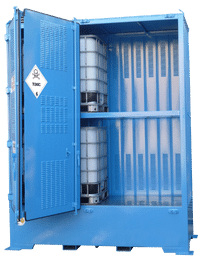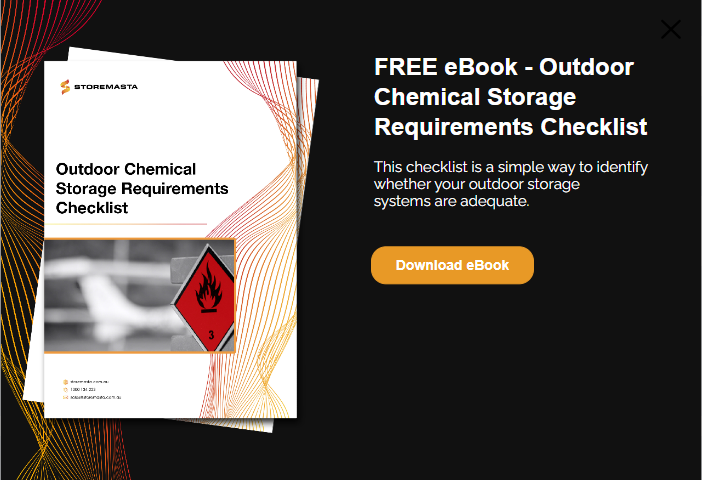While choosing compliant outdoor chemical storage is the key in keeping incompatible substances segregated in the workplace, there are other handling and storing practices that you can take to reduce risk. This blog will explain the requirements that apply to mixed classes of dangerous goods, and how this can be applied your outdoor chemical storage and handling areas.
How Should You Store and Handle Multiple Chemical Classes?
There are many ways to accommodate the safe storage of multiple classes of chemicals in the workplace. The emphasis should be on understanding the risks associated with each chemical that you have onsite – and then determining the additional risks that may occur due to chemical incompatibilities.
As we mentioned in the previous blog, there are specific distances that chemical classes should be kept from one another to reduce the likelihood of a hazard occurring. You can find these specific distances in our dangerous goods segregation chart.
In addition to adhering to the segregation rules, there are many other ways that you can reduce risk when working with multiple classes of chemicals. We’ll look at the storage requirements for package and IBC stores, as well as the benefits of choosing individual chemical storage containers to successfully segregate incompatible substances and those that can react dangerously.
REMEMBER: Effective dangerous goods segregation is not just a chemical safety issue, it’s a requirement under Australian WHS Law.
General Requirements for Package and IBC Stores
If your organisation is storing mixed classes of dangerous goods, you must refer to AS NZS 3833 – The storage and handling of mixed classes of dangerous goods, in packages and intermediate bulk containers.
This Australian Standard should be referred to in addition to the specific standard that relates to your individual dangerous goods classes of chemicals.
In Section 5 of the Standard, it details the stores applicable for mixed classes of dangerous goods (which may be one or a combination of the following stores).
Some of these include:
- A roofed structure or room, attached to an external wall of another building
- A free-standing, roof structure or building not attached to other buildings
- An outdoor storage area with a security fence
- A compliant cabinet/store

There are a multitude of ways to store mixed classes of dangerous goods in the outdoor environment, including in compliant cabinets or stores.
A risk assessment must be conducted if you choose to store mixed classes of dangerous goods at your site. Always obtain the current SDS for each of your products to fully determine the segregation requirements. while there are general guidelines to denote incompatabilities, your segregation distances should be unique for your site. They are no longer a stock standard rule, such as the 3m or 5m segregation rule.
Consideration may be given to:
- Compatibility of the different goods
- Nature of each type of goods
- Quantity of dangerous goods
- Type of packaging used for the goods
- Fire hazard
- Other risk factors
Spillage
You must also consider how the dangerous goods segregation requirements will be applied — and if there is appropriate spillage control for the store. If you do choose to store mixed classes in the same area or store, you must also keep in mind that any leaks or spillage must be directed into separate liquid-tight spill containment systems. This is to prevent the likelihood of chemical reactions or hazards occurring if the chemicals meet.
.jpg?width=650&height=433&name=Responding%20to%20a%20flammable%20liquids%20spill%20(1).jpg)
The successful containment of leaks and spills is key in risk reduction when you’re storing any type or quantity of dangerous goods.
Section 5.4.3 Spillage containment explains that :
(f) Chemicals that could be incompatible shall not be directed into a common compound.
NOTE: For example, this includes the possible combination of ammonium nitrate and flammable or combustible liquids.
(g) Spillage containment shall be designed so that substances that might react dangerously are not directed into the same compound.
NOTE: Environmental legislative requirements also apply. (h) All surfaces of the spillage containment system shall be non-porous and chemically resistant to all stored liquids.
Ventilation
Chemical stores must be provided with adequate natural or mechanical ventilation capable of maintaining the ambient concentration of vapours or dusts throughout the store. Refer to the workplace exposure standards to understand the legal limits that apply to your onsite chemicals.
The ventilation system for your outdoor store will be determined by the goods being stored, as well as any vehicle fumes which may be emitted.
IMPORTANT: All ventilation systems must comply with the requirements of the Australian Standards — see Section 5.4.5 for detailed information regarding the requirements for natural and mechanical ventilation systems.
The Benefits of Chemical Storage Containers
Outdoor chemical storage containers, such as outdoor IBC stores, that are constructed in full conformance with Australian Standards can assist with reducing risk for businesses carrying multiple classes of dangerous goods.
We recommend this chemical storage method as it segregates dangerous goods classes from each other with storage that’s specifically designed to reduce the risks posed by that particular chemical class. These relocatable containers are regarded as a simple, cost-effective storage option that is suitable for the large majority of businesses — as the ready-made containers are already equipped with all the necessary controls.
When you’re considering your outdoor chemical storage requirements, you must ensure that each class of chemical is housed in a container that’s been specifically designed and manufactured to meet the requirements of the relevant Australian Standard.
Flammable liquids, for example, are subject to some of the strictest requirements due to the volatility of the substance and the potential for fire and explosion. Those containers manufactured to meet the requirements of AS 1940 – The handling and storage of flammable and combustible liquids offer a range of controls to reduce risk including:
- Natural ventilation for the dispersion of hazardous vapours – reducing the build-up of flammable vapours within the container that could result in a fire, explosion or dangerous reaction
- Sheet steel construction offering protection from impact damage – minimising the impact of workplace accidents ie equipment being knocked into your chemical store
- Cyclonic proof construction – offering protection against the elements and further stability for your store
- Liquid-tight flammable liquids spill containment system – to reduce the risk of volatile liquids spilling into the work environment, resulting in ignition, explosion or chemical reaction with incompatible substances
IMPORTANT: If storing a range of chemical products in your organisation, choosing a compliant outdoor chemical storage container for each dangerous goods class will reduce the risks associated with the chemicals. It will also provide the necessary controls to reduce hazards associated with incompatible substances and those which react dangerously.
General Storage Practices
When storing any type of chemical in the workplace, it’s important to implement procedures to help workers adhere to the correct storage and handling practices.
Some suggestions include:
- Always provide clear access to the chemical store
- Store packages in a way that prevents them from falling and causing spillage
- If packages are opened in the store, safety showers, eyewash facilities and water for hand-washing must be placed within 2 – 10 metres of the area. Note: Your onsite risk assessment should fully determine your emergency decontamination requirements including the number, location and type of equipment required.
- Equipment and forklifts should not create further hazards for dangerous goods, such as oxidizing agents or those that may produce flammable vapours, gases or combustible dust
- Safe stacking and loading practices should be developed and implemented
- IBCs should not be stacked more than 2 high unless the store has purpose-built racking
When working with chemical package stores, make sure that packages are stacked and loaded in a safe manner that reduces spillage risk.
Segregation Within the DG Store
Dangerous goods must be segregated from:
- Incompatible substances
- Substances with which they might react dangerously, and
- Other dangerous goods
REMEMBER: You can determine the incompatibility of your chemicals by referring to your individual Safety Data Sheets. This information can then be references to the dangerous goods segregation chart, which will provide the necessary separation distances.
The following general requirements apply to segregation within stores:
Incompatible Substances:
- Must be kept in separate compounds; or
- Must be segregated by a distance determined by your own risk assessment
Storage of Non-Dangerous Goods In Segregation Spaces
In certain circumstances, non-dangerous goods may be kept in segregation spaces – as long as these non-dangerous goods do not react dangerously with the stored chemicals. A risk assessment should be performed to determine if the mixed goods will create a chemical hazard.
Handling Practices
No activities, such as package filling, co-storage, mixing, blending, tinting or degreasing, should be carried out in a chemical store unless a risk assessment has been conducted and a risk management plan is implemented.
General precautions for the handling of dangerous goods include:
- The careful handling of chemical packages to reduce the likelihood of leaks and spills
- Provision for personal protective equipment (PPE) as stated in the SDS
- Packages or IBCs must be protected from punctures or tears caused by pallets
- Manual handling risk controls must be implemented and maintained to control the movement of packaged dangerous goods
IMPORTANT: Procedures, training and supervision are required for any staff member or contractor who is handling any type of dangerous goods. When working in an organisation that carries several classes of chemicals, all relevant staff must be aware of, and trained to reduce the hazards, of each of the chemical classes. Understanding the dangerous goods segregation rules is crucial for staff and contractors in this type of environment.
Carrying Multiple Classes of Chemicals?
While storing larger quantities of chemicals in the outdoor environment already poses a range of risks, carrying multiple classes of dangerous goods further increases the potential for hazards. As we’ve highlighted in our blog, there are strict and detailed requirements that specifically relate to the storage of mixed classes of dangerous goods. While practicing the correct dangerous goods segregation rules is essential for compliance and safety, it’s also important to consider how you handle and store your chemicals.
One of the easiest ways to immediately reduce risk is by installing outdoor chemical storage containers made in full conformance with the relevant Australian Standard. This will not only reduce the risks associated with your stored chemicals, but it will allow for the correct segregation of incompatible substances. To learn more about compliant outdoor chemical storage, why not access our handy checklist? Grab your copy for free today by simply clicking on the below image.
Like what you’re reading?
Check out Part 1 of our short blog series: Outdoor Chemical Storage: Mixed Classes of Dangerous Goods
Joining the team as a Dangerous Goods Storage Consultant, Melissa Hampton became Storemasta's Marketing Manager in late 2021. With extensive knowledge and experience in chemical compliance, Melissa is responsible for leading the Marketing team and helping shape their marketing strategy. In her spare time, you can find Melissa hiking, swimming and enjoying the great outdoors in beautiful north-west Tasmania.

